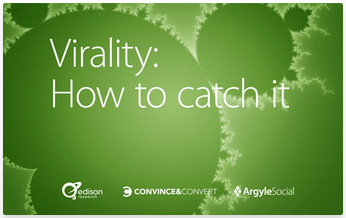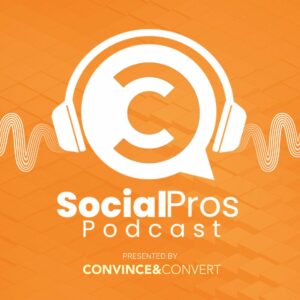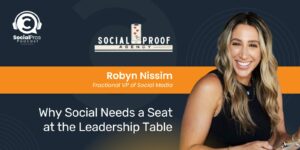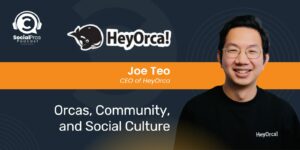Hosted By
About Social Pros Podcast:
Social Pros is one of the longest-running marketing podcasts in existence (10 YEARS and counting), and was recently recognized as the #1 Audio/Podcast Series by the Content Marketing Awards.
Our purpose? Making sure that we speak to real people doing real work in social media.
Listeners get inside stories and behind-the-scenes secrets about how teams at companies like Google, Reddit, Glossier, Zillow, Lyft, Marvel, and dozens more, staff, operate, and measure their social media programs. With 600+ episodes, the Social Pros Podcast brings the humanity of social media to the forefront, while providing incredibly useful marketing strategies that listeners can immediately implement.
Follow Social Pros on LinkedIn.
To inquire about becoming a guest or show sponsor, please email our Executive Producer, Leanna Pham, at leanna@convinceandconvert.com.
Apple Podcast Reviews:
The Social Pros podcast has quickly become a favorite in my feed! I'm consistently impressed by the engaging conversations, insightful content, and actionable ideas. I truly learn something every time I listen!
@Arlie KThis is absolutely an awesome listen for anyone in communications or social media!!
@Will31CThis podcast has become one of my staple weekly podcasts for learning about marketing! Love the conversations that they have and it's always enjoyable and educational!
@Simonstone95Love the podcast - informative, in depth and spot on for any business size.
@MissTriathlon
Chuck Hemann, Director of Analytics at WCG, joins the Social Pros Podcast this week to tell us about the difference between analytics and insight in the social branding sphere, and the importance of both. Read on for some of the highlights or listen below for the full podcast. Listen Now Click the play button to listen […]

Chuck Hemann, Director of Analytics at WCG, joins the Social Pros Podcast this week to tell us about the difference between analytics and insight in the social branding sphere, and the importance of both. Read on for some of the highlights or listen below for the full podcast.
Listen Now
Click the play button to listen here:
[podcast]http://socialpros.podbean.com/mf/web/asq662/SocialProsEpisode38.mp3[/podcast]
Download the audio file:
http://socialpros.podbean.com/mf/web/asq662/SocialProsEpisode38.mp3
The RSS feed is: http://feeds.feedburner.com/socialprospodcast
Find us on iTunes: http://itunes.apple.com/us/podcast/convince-convert-blog-social/id499844469
Please Support Our Sponsors
Huge thanks to data-driven social media management software company Argyle Social for their presenting sponsorship, as well as Infusionsoft, Janrain, and Jim Kukral at DigitalBookLaunch. We use Argyle Social for our social engagement; we use Infusionsoft for our email; Janrain is our crackerjack social integration company, and Jim is our guest host for the podcast (and a smart guy).
Social Pros Highlights For Your Reading Enjoyment, Thanks to Speechpad for the Transcription
Listening is Believing
Jay: Tell us what a director of analytics for a big, world-class digital agency does day to day.
Chuck: It’s actually multifaceted. What we really try to do is help our clients understand how their customers (current or potential), employees, investors, name your stakeholder here, are talking about the brand, the competitors, the industry segments, how they’re talking online. What we really try to focus on are deep insights into the customer that help shape strategy and tactics, both current and long term.
 Jay: Does that mean that more of the work that we’re doing is around social chatter analysis and things of that nature, more so than click stream analysis from social?
Jay: Does that mean that more of the work that we’re doing is around social chatter analysis and things of that nature, more so than click stream analysis from social?
Chuck: It depends. We do a little bit of the latter, but even with social’s explosion there are still a number of brands that have either started or want to start using social media more effectively. They come to us, saying, “We need to really understand what the landscape looks like before we try to develop strategies or tactics.” I think there is still the element of “test and learn” that happens online. I think our really in depth, data-driven approach is what clients are glomming onto right now.
There is a level of really deep insight that can be gleaned from reading and analyzing social conversations. I think you just have to have a deep understanding of what the business is, a deep understanding of what the goals are, and deep understanding of who your customer typically is. You can fashion listening profiles or search keywords, whatever you want to call it, to glean those kinds of insights.
Jay: When you’re talking about those insights, though, it’s not so much numerical as it is contextual and relevancy, right? It’s more a natural language processing what’s really being said, more so than share of voice or even baseline sentiment.
Chuck: I think that’s a fair comment to make. We tend to focus on that qualitative insight. If one of our clients is home improvement for example, an insight we might give them is that 90% of their customers are participating in forums, but in forums they’re talking about X, Y, and Z topics. The client, while they care that 90% of their customers are talking in forums, what they really care about are the qualitative assessment about each of those three topics that are happening within that forum.
A Willing Focus on Social
Eric: When you go into these relationships, do you find that you’re having to make the case for investment in social?
Chuck: My career started in traditional media analytics. Trying to get budget for traditional media research is like trying to walk across the Grand Canyon with no water and no shoes. It’s a really painful process.

Now though, something has flipped, where clients and companies of all sizes really care about investing in that upfront research to make sure they are doing the right thing. It could be that risk aversion. It could be that it’s a brand new channel and they’re trying to understand it before they launch. There is less pushback than ever before to get this kind of insight.
I think the way we have approached it internally at WCG is we modeled it so that we’re going to tell you where customers are talking, what they’re talking about, when they’re talking about it, and to some element why they’re talking about it. That’s a tried and true approach that we use with every company. For the most part, companies are really embracing the data-driven approach.
Jay: You’re basically a professional eavesdropper?
Chuck: The reality is that there is somebody like me that’s sitting there studying why you typed into Google what you typed in. We’re also trying to study why you liked a particular piece of content, why you shared a particular piece of content. We’re also analyzing why you’re talking about the brand. Do you love it? Do you hate it? Did you have a terrible experience and we’ve got an opportunity to rectify it? There is somebody on the other end that’s trying to make heads or tails of that.
Even being in this business, anytime I will tweet or post about a particular brand and the brand reaches out, I am always super-excited that they’ve reached out to me. I wonder what they’re using to listen to my conversations, what keywords triggered the outreach. Every customer loves to be contacted like that. Obviously there are some limits to that, but generally speaking I can’t imagine a scenario where you wouldn’t love to be contacted after tweeting about something and somebody listened to the conversation and chimed in.
Understanding the Data
Jay: Do you think we put too much emphasis on the software and not enough emphasis on the interpretation?
Chuck: To be honest with you, we still see the scenario play out where a business unit within a large company hasn’t started with social media, and they’re going to get started. The first place they go is to the listening tools, and this is not a knock on the listening tools.

They say, “We want to get started in social, and we think we need to start listening.” Well, that’s a great strategy, and what anybody that’s been in this business for any length of time will tell you is that is a very expensive investment and tends to fail, eight times out of ten, nine times out of ten. Because there is no human element on the back end that can manage that tool, develop insights, and that also know the business.
The tool is not going to know your business. They aren’t going to be able to sit there with the team 24/7 and train them up. The progression should be: we care about a data-driven approach, let’s bring in somebody that can lead the analytics for us. Let’s let them pick the tool, let’s let them frame up how we’re going to develop insights. Let’s let them frame up how these insights are going to spread within the organization. Instead of a marketing team that’s already overburdened picking a tool before they’re ready and letting it sit on the shelf for 12 months before they realized it was a terrible investment. It’s because there was never a person on the back end to interpret the data.
Jay: The future is not big data, the future is big understanding, and it’s not the same thing. What does your team look like?
Chuck: There are a lot of mini-Chucks on my team, to be totally honest. I am really blessed with a fantastic team. It’s a mixture of folks, so we have people that came from traditional PR that loved measurement and analytics and data and have made their way into digital and social and found a home. We have people that are long standing research pros. We have more junior programming type folks.
Really, there isn’t a well defined skill set for digital analytics these days. It’s sort of “know them when you see them.” I will tell you that the common refrain, and it’s something you will never see within a LinkedIn profile, is a natural curiosity. I can teach people the social and digital side. If they don’t have that natural curiosity, some element of a research background, they will fail miserably in this job.
The Secret Sauce
Eric: Can you give me the Twitter version of the Chuck Hemann method? What of that is secret sauce that you’re willing to share to our audience?
Chuck: I think if I were to put it into three steps, it would be: understanding the business, fine tuning the tool, developing the insights. Because to be honest to you, our team uses the tool as a mechanism to grab data. We care about the raw data that you can deliver. If we get that raw data, the team will sit there and scrub and clean out any spam and clean out any duplicate and clean out any irrelevant mention. Then starts the process of developing the insights.
I don’t think it’s any sort of proprietary methodology, but the team literally will spend a considerable amount of time, after they’ve cleaned it up, reading posts and coding. When we go in and we present to clients, and a client will point to one particular insight, our team will be able to say, “Yeah, I actually remember reading a post in October that talked about this topic and this topic, and here’s who wrote it and here’s what kind of engagement they got on that post.” That really deep level of insights is one of the reasons that I think we’ve been successful.
Chuck: Right. One of the things we provide is scale. There are eight analysts on my team. Across the WCG network we have 50 analysts on staff, and so there are people that know a hell of a lot about [their niche] that can sit there and understand what the trends should be and then look at the actual data about the client, the industry, the competitor and say, “Okay, wow, here are the four or five insights that we can deliver.”
Jay: That’s an interesting point, Chuck. You have your analysts not just on your team but across the network deployed on vertical it sounds like, and it also sounds like individual analysts stay in that analytical role with a particular client for a while. They’re working on one piece of business so they can develop that institutional data knowledge.
Chuck: Yes, the way we typically structure the teams is if you are on a particular piece of business from the get go, from the initial project, we try not to move you off of it. Chances are good you’ve developed a good relationship with the client.

What we also try to do, in the same breath, is not keep somebody on a particular piece of business for 18 months, 24 months and beyond, because to be honest with you your eye grows stale, the conversation doesn’t change that much. We want to make sure we’re still delivering the best insights we can.
Consumer Insights vs Real Time Reporting
Jay: Because you’re doing all the deep dive work, does that mean that your team is not doing the kind of real time conversation monitoring? Or if you are, is it a different group for a different purpose?
Chuck: It is part of the same group and we are doing the real time reporting. I think there’s two different models. I think that real time reporting is great in the event of a crisis. What we’ve been talking about for the first part of this show is really the deep dive consumer insights, totally different animals. Real time reporting I would never rely on as a benchmark for how our consumers are behaving. It’s a really small blip in time.
The one caveat to that I would say though is if more companies, as they’re moving and believing in the power of data, are starting to merge the content development process more closely with that data gathering and insights development process, toward a level where they’re building and developing content in real time, or near real time. That is the one exception to that real time monitoring rule. Otherwise it’s helpful for crisis reporting or event reporting, and not a heck of a lot else in my opinion.
Jay: I think that’s a really important distinction and one that does not get talked about enough. What many people are trying to do is take the same software tool and say, “This tool is equally good for real time conversation monitoring and engagement and deep insights.” While it’s true that some of those tools can be used for both, it seems to me like that is a high bar to clear. Maybe it’s two different tools for two different jobs.
Chuck: Yes. It’s a function of resources to be able to do that mining, insights development, and then feeding it to somebody that can build content in real time. It’s a gargantuan challenge. It’s where we need to get to I think ultimately, but it’s a long ways off I think in many cases.
Social Media Stat of the Week: 0.0006% of Tweets Go Viral
Eric: The number today is 0.0006%. This is a homegrown number from some research that we’ve been doing at Argyle. Actually, Jay Baer and Tom Webster helps us present this research on a webcast last week. 0.0006, based on an analysis of over a million Twitter posts across a variety of industries and community sizes.
We found that that’s the percentage of tweets that got more retweets than followers. Just to explain, 0.0006%, the number of tweets that have more retweets than followers. That’s the percentage of tweets that went “viral.” That is a really, really, really small number.

Jay: Yeah. If your social media marketing program calls for you to send out a bunch of tweets and for those tweets to catch fire, the chances are 0.0006% that will actually succeed. That’s a staggering number, right? That is a very tiny grain of sand in a large beach of tweets. What lesson do you draw from that?
Eric: One of the things we discussed in this conversation was that hope is, indeed, not a strategy. These companies that have had wild viral successes have actually in many cases done a ton of work, and tons of testing and learning and failure before they finally hit on a strategy that worked. These are companies that have lots of resources and lots of time and a reasonable business case for investing this kind of effort. For the vast majority of businesses, virality probably shouldn’t be the goal, and it really should be more about creating value and creating connections and doing the hard work, day in and day out. Any viral lift that you get is gravy on top of the primary goals.
Jay: Excellent. Well, I’m not sure whether I’m heartened or disheartened by that, but that’s what it’s going to be.
Chuck: One of the things we talk about a lot internally is the importance of visual content. If we stripped away all the text from online, would your brand’s story still be told just through a visual content?
I was struck by the Social Habit preview that you guys gave me, to see the growth in Instagram popularity. It’s amazing to me to see that awareness level jumping. The importance of visual content is going to be long lasting, and I would only expect Instagram’s popularity and awareness levels to grow.
Social Pros Shoutout
Chuck: I will give two different shout-outs. Since I am in the Loveland-Dallas metroplex area today, I will shout-out to Robert Freeman. He’s director of digital and social at Michael’s stores. Really, really sharp guy. Disclaimer: he is a client of ours. But he is an unbelievably sharp guy and doesn’t get as much exposure as he should get.
The other one is somebody that’s probably not under the radar, but I would throw out a shout-out to Adam Kmiec. I think building a digital and social program at a CPG the size of Campbell Soup is probably not a really easy task. The fact that he is building that team is a laudable thing.
Jay: Chuck, you were fantastic as expected, as instructed. Thank you very much for being a part of Social Pros.
Chuck: You’re welcome. Thanks guys for having me on. I appreciate it.
Jay: Who do we have on the show next week? It is Rick Wion, head of social media for a little company you may have heard of, called McDonald’s. Rick is a great guy, super-smart, has done a lot of interesting experimentation with social, and obviously has to operate at scale. You think you’ve got a lot of social mentions every day, imagine being McDonald’s. We’ll talk to him a little bit next week. Looking forward to it.
See you next week.







